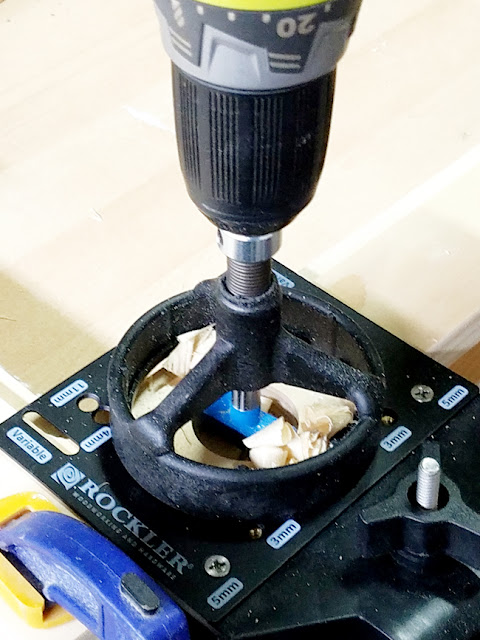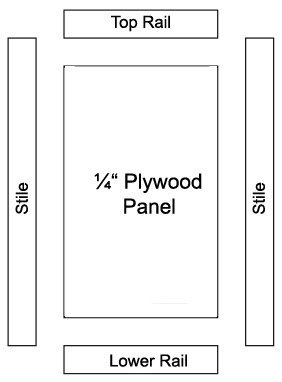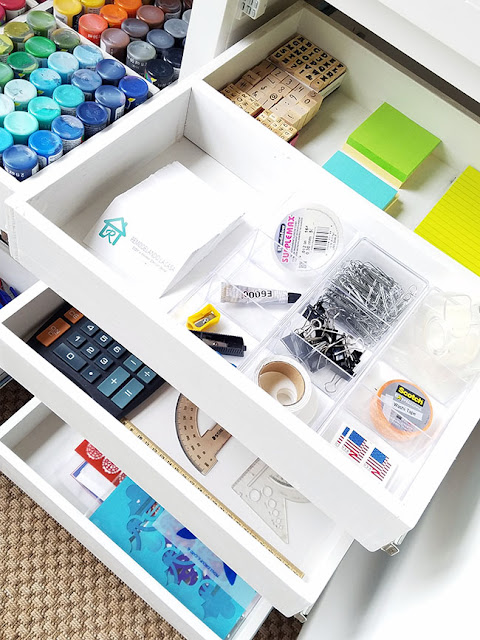Creating two sets of inset cabinet doors was a job that I kept on postponing for a very long time. Finally, I decided to tackle this job and the one thing I now ask myself is why it took me so long? It wasn't that difficult!
It was exactly a year ago when I was in a rush to finish this room and have it ready for Christmas. Installing the coffered ceiling and painting the entire room were the last big tasks I tackled, but there were many little details that I postponed for "later".
Installing the quarter round and the cabinet doors were some of those finishing details that were driving me crazy, and it was only a month ago that I decided to put an end to that story.
From the moment that I got rid of the tiny baseboards to the almost complete room you see in the picture above, there was a big lapse of time.
You can check every step of that process by clicking on the links at the end of this post.
For now, let's build THE DOORS!
I think I was a bit scared to build this kind of door, and maybe that's why it took me a year to do it. After all, these were the very first doors I was going to build! 😨
So, this is not a tutorial. I'm going to give you all the details of what I did, in case you're thinking of giving the inset doors a try. ;)
The good thing is, now that I've gone thru it, I don't think they were that difficult to build! My cabinets and doors are far from perfect, but guess what? They are working and the doors are opening and closing without trouble and that's the most important thing to me. So, let me show you how it all went:
For the rails and stiles, I used 1 x 3 pine material.
For the inside panel, I used ¼" plywood.
1. MEASURE & CUT THE MATERIAL
The first step I took was to go and measure the opening of the cabinets very well.
The size of the doors was set following those measurements, giving a 1/16" clearance all around the door.
Having the measurements at hand, I cut the material to size using a miter saw.
 |
| Ryobi ONE+ Trim Router |
2. MAKE RABBET CUTS
Since I don't have a routing table or table saw, which would've been the easiest way to make the grooves on the stiles and rails, I decided to use a handheld router to make the rabbet cuts, which are the groves where the panel would sit.
 |
| Kreg Jig | Drill |
3. DRILL POCKET HOLES
The stiles and rails were connected with pocket hole joinery. Using the Kreg Jig, two pocket holes were drilled on each side of the rails.
 |
| Milwaukee 11in. 1 Multi-Tip Screwdriver with Square Drive Bits |
4. ASSEMBLE THE FRAMES
Using 1¼" screws the frames were put together.
Note: At this point, I didn't use glue and I used a screwdriver with a square drive bit to secure the pieces together nicely. This is a dry-fit, if the frame is too big or too small you might need to disassemble it to fix things.
If you're building many doors, LABEL them!
5. DRY-FIT
Once the frames were done, I went ahead to try them on the cabinets. It must've been beginner's luck or the fact that I'm finally taking good measurements because they fit perfectly!! ☺️
Note: At this point, I didn't use glue and I used a screwdriver with a square drive bit to secure the pieces together nicely. This is a dry-fit, if the frame is too big or too small you might need to disassemble it to fix things.
If you're building many doors, LABEL them!
5. DRY-FIT
Once the frames were done, I went ahead to try them on the cabinets. It must've been beginner's luck or the fact that I'm finally taking good measurements because they fit perfectly!! ☺️
 |
| Rockler Jig It | Long Shank Carbide Forstner Bit |
6. DRILL THE CONCEALED HINGE CUP HOLES
The whole hinge part is craziness when you're a cabinet door-building rookie! There are thousands of hinges out there. I had to take a crash course on this matter even before I bought the wooden material.
My key points for choosing the hinges I chose were these:
The holes were set at 3" from the top and bottom of the door. The hinge instructions let you know if you have to set the jig at 3mm. or 5mm. Then, it's just a matter of clamping the jig and drilling the hole or holes.
The whole hinge part is craziness when you're a cabinet door-building rookie! There are thousands of hinges out there. I had to take a crash course on this matter even before I bought the wooden material.
My key points for choosing the hinges I chose were these:
- They had to be concealed - not showing.
- Good for inset doors.
- They had to be good for face frame cabinets.
- The other good points with the hinges I chose: soft closed and three-way adjustability.
The holes were set at 3" from the top and bottom of the door. The hinge instructions let you know if you have to set the jig at 3mm. or 5mm. Then, it's just a matter of clamping the jig and drilling the hole or holes.
 |
| Blum Inset Face Frame Hinges |
Using the jig gave me peace of mind and I had no trouble whatsoever with the eight holes I had to drill.
7. INSTALL THE PANELS
The ¼" Plywood was cut to size. Those corners were adjusted with a utility knife and the plywood corners were rounded.
7. INSTALL THE PANELS
The ¼" Plywood was cut to size. Those corners were adjusted with a utility knife and the plywood corners were rounded.
 |
| Makita 23-Gauge Cordless Pin Nailer |
8. FILL GAPS AND HOLES WITH WOOD FILLER
The pocket holes and gaps were closed with wood filler, sanding them smooth.
Sand the entire door and clean it very well before going on to the next step.
The pocket holes and gaps were closed with wood filler, sanding them smooth.
Sand the entire door and clean it very well before going on to the next step.
 |
| DeWalt Sander | SandNet Sanding Discs | Wagner Home Decor paint sprayer |
9. PRIME AND PAINT
Use a good-quality primer to prepare the wood for the final finish. I gave the doors two coats of primer, sanding with a 120 grid sandpaper between coats.
Then, using a paint sprayer I gave the doors two coats of paint in a semi-gloss finish.
10. INSTALL THE DOORS
The final step is to install the doors, installing the hinge part onto the cabinet. I had to confess that I didn't do this part. That's another item that goes to my list of things I don't like doing. :/ And ha, Mr. RLC didn't want to deal with this job either. I had to call my bil and he spent like an hour installing all four doors.
Use a good-quality primer to prepare the wood for the final finish. I gave the doors two coats of primer, sanding with a 120 grid sandpaper between coats.
Then, using a paint sprayer I gave the doors two coats of paint in a semi-gloss finish.
10. INSTALL THE DOORS
The final step is to install the doors, installing the hinge part onto the cabinet. I had to confess that I didn't do this part. That's another item that goes to my list of things I don't like doing. :/ And ha, Mr. RLC didn't want to deal with this job either. I had to call my bil and he spent like an hour installing all four doors.
Well, that's pretty much how it all went.
I began organizing all my stuff in there. Oh, we also added door stoppers, the doors were getting a bit inside the cabinet.
 |
| | Cabinet Knobs | |
They still need some more adjustment, some sides have a bigger gap than the other, but my BIL said he'll do it one of these days. I'm so glad for all of his help!
Overall, I'm SO happy with these doors, they look good, and as I said... They're far from perfect, but they're opening and closing and that's the main thing! ;)
 |
| | Shibori Tapestry Wall Art | Door trim | |
In my next post, I'm going to show you how this room looks now as my office. Stay tuned!
Part 10: The Final Reveal
This post contains affiliate links.
















Christina -- you are my "she-ro"! I am so impressed with all of your projects. You are an inspiration. I do a lot of DIY projects, but not to the extent you do. One thing I might share, you can get outlet box extenders (I got mine at Lowes -- they are blue plastic which inserts into the outlet space in front of the original box. You pull the wires through and the extender then is anchored to the front of the cabinet or wall face. Replace the cover and it is completely flush!
ReplyDeleteHehehe I like that she-ro word! Thanks so much girl. 💕 I remember using those outlet extenders in the kitchen when installing the backsplash. I have never used that outlet there inside that cabinet that I guess I didn't even pay much attention to the fact that is so recessed back. Next time I get to the big store I'll buy one. Thanks! ;)
DeleteWhat a great outcome! If I thought for one minute I could make doors like that, I'd start today! You did a great job and provided great directions. Super congrats on a difficult project. As always, it's perfection! ~~ Susie from The Chelsea Project
ReplyDeleteOh, I'm sure you can, Susie! Now even more, after all the work you just completed! ;)
DeleteCristina, I'm impressed every single time you share a project like this. Many years ago I took a woodworking class on Wednesday nights with my friend. Actually it wasn't a formal class. The teacher was a daytime shop teacher and told us we could make anything we wanted. My first project was a cherry blanket chest made from rough lumber. Yup... that meant I had to join, glue, and plane the boards. They came out pretty well. Except, the breadboard end on the top, a chip came out of the wood because the glue stuck to the clamp. It's amazing how strong glue is. The Top board was so heavy that the shop teacher and his friend cut the finish edge for me on the machine that is like a router but is on a stand. (I think it has a different name but I can't remember.) Otherwise I did it all myself with lots of coaching of course. I was scared to death to use those machines, but I did it scared. Over the course of a few years I made lots of items and gave away many as gifts. And that was the end of my woodworking career. We've just moved around too much and I've lost my nerve for using power tools. It takes nerve and I applaud you. Your work may not be perfect to you... but I think you should be very proud of what you've accomplished. You and your project are FABULOUS!!
ReplyDeleteXO
Isn't it amazing all the experiences we have gone thru? As I was reading your story I could just see the twinkle of wonder in your eye, witnessing the beautiful cherry blanket chest you had just created! It's sad to hear you didn't continue that path. Otherwise you would've been a master carpenter right now! :) Its never too late to jump back on the horse ;)
DeleteMy first woodworking experience happened when I was in high school in my natal Colombia, it wasn't that greatest first experience. I enrolled in this woodworking class and I had to create a shelf, a small decorative shelf. The first task was to smooth out the piece of wood we had brought. Well, I spent a whole lot of time using a hand plane to smooth that piece but no matter how hard I tried it didn't get smooth! It turned out that the board had a layer of cement on it. :/ The teacher had to use the heavy equipment to get rid of that stuff. So, even though I finished the little shelf, I wasn't impressed with woodworking. Who would have known that almost 30 years later I would immerse myself into it?! The desire to bring beauty to my home was so strong that I had to do it. There was no way around it! And even now, as I finish each of my projects I stand there in disbelief that I'm able to do such kind of work.
Diane, thanks so much for your heartfelt comment and as I said it before, for being a cheering, motivating and inspiring force!
Hugs,
Cristina
Cristina, these cabinet doors are amazing! I have saved your post in my favorites. I have asked santa for Kreg this Christmas and I am hoping to learn to make cabinet doors. Do you have a tutorial on how to use a router for beginners? And would you tell me what router bit you used? How did you determine the size of the plywood inset? Thank you
ReplyDeleteCynthia Schuster - Parker, CO
Thanks Cynthia! No, I don't have a tutorial on how to use the router, but there are thousands of them on the web. Also, many video tutorials on You Tube that you can watch. I used a ½" rabbeting router bit. I determined the size of the plywood insets after the frame was assembled, measuring that inner part. There on Step 7, you can even see, I placed the plywood piece on top of the frame to mark its length.
DeleteHey, good luck with Santa's request. That's an amazing tool!
Awesome job with the doors, they came out great!
ReplyDeleteThanks so much!! Far from perfect, but they're still doing their job. :)
Delete